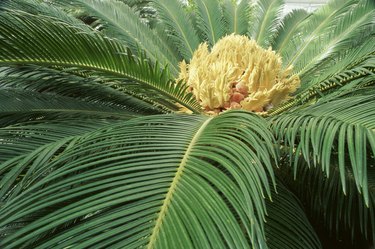
Finding scale insects on your sago palms (Cycas revoluta) is no laughing matter, so you want to learn how to treat scale on sago palms quickly. The false oleander scale and the Asian cycad scale both feed on the sap of sago palms. False oleander scales occur wherever sagos grow in U.S. Department of Agriculture plant hardiness zones 9 through 12. The cycad scales have a limited range outside their native southeastern Asian habitat.
Identify Scale on Sago Palms
Video of the Day
Both pests construct predator-proof armor from their shed skins and sticky wax secretions. Asian cycad females have flat, rounded armor. False oleander scales are more elongated. The former infest the crowns and older leaves and then move to the fronds' surfaces and midribs. Their colonies eventually cover entire plants, including the cones, seeds and roots. The latter remain on the backs of the fronds.
Video of the Day
Recognize the Symptoms
Before you treat scale on sago palms, observe the symptoms to identify the type. Both insects cause yellow spotting on the fronds' upper surfaces. Fronds with false oleander scales become completely yellow and drop prematurely. Those hosting cycad scales turn brown and wither. False oleander scales seldom harm the plants, but cycad scales reproduce at an astonishing rate and may kill small sagos within weeks.
Start With Cultural Treatments
Prune fronds with large numbers of false oleander scales to treat scale on sago palms. Rinse your pruning tools in rubbing alcohol between cuts and after use so they don't spread scale nymphs, and dispose of the fronds in sealed plastic bags. Pruning may also treat early cycad scale infestations.
Another possibility is to use a garden hose to spray the scales off with a strong stream of water. For this to work on cycad scales, monitor their numbers constantly and drench both surfaces of each frond, along with the trunks and the cones.
Attract Biological Controls
Chewed scale armor that houses no insects is the work of the singular black lady beetle (Lindorus lophanthae), a primary false oleander scale predator. To attract more of them to treat scale on sago palms, plant light-colored, pollen-producing flowers such as perennial golden marguerite (Anthemis tinctoria), suitable for U.S. Department of Agriculture plant hardiness zones 3 through 7, or annual White Sensation cosmos (Cosmos bipinnatus 'White Sensation').
Use Horticultural Oil
Pruning and predators normally keep false oleander scales in check. If you need an insecticide to treat cycad scale, try horticultural oil. Spray biweekly when temperatures average 70 degrees Fahrenheit or higher and monthly in cooler weather to treat scale on sago palms. Among the available insecticides, the oil poses the least risk to bees and other beneficial insects when used according to label directions. On a calm, clear early morning with no rain in the forecast, water your sagos and spray while the temperature is below 90 degrees Fahrenheit.
To use horticultural oil as a spray, dress in a long-sleeved shirt, long pants, socks, shoes and a hat. Wear chemical-proof gloves, protective eyewear and a respiratory mask. Mix the concentrated oil with water in a pressurized tank sprayer according to label directions.
Lift each frond individually and spray both the top and bottom surfaces until they drip. Spray the base of the crown, trunk and cones, getting into all the crevices. Also spray the soil around the sagos every other month to kill nymphs migrating to the roots. After spraying, discard the leftover solution where it won't flow into drainage systems or surface water.